5 min read
How to run your electric underfloor heating system
With the colder months fast approaching, many homeowners will start to think about turning on their heating and some may even be getting new heating...

It won’t be long before we start thinking about turning the heating on to combat the chill of the winter months. As the heating season fast approaches, we look at underfloor heating thermostats which brings together the information you need to know, all in one place. We’ll be covering:
If you are looking for more in-depth technical support, we recommend checking out our thermostat video guides or contacting one of the team at ThermoSphere HQ.
Manual thermostats
If you want to be energy efficient avoid manual thermostats because they are not LOT 20 compliant which means they don’t have any energy saving features. However, if you are looking for a simple on/off for your system which can measure the temperature of the room and the floor, then a manual thermostat will be a cost-effective option. You’ll also find that they are the cheapest of the thermostat category too.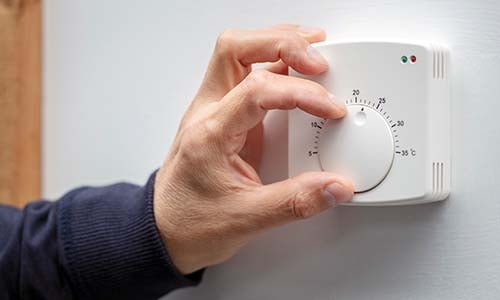
Standard programmable thermostats
Programmable thermostats are the most popular type of thermostat used with underfloor heating. They come with a suite of features which are great for energy-efficiency and your bank balance. Open window detection, as example, will sense a drop in temperature caused by an open window or door, it will turn off the heating for 15 minutes and then turn it on again which reduces energy waste.
Another clever feature of programmable thermostats is the smart adaptive start-up function which learns how long it takes for your floor to heat up. By learning this, your room will be at the right temperature at exactly the time you want it to be. The great thing about programmable thermostats is that you can easily create a heating schedule to fit your lifestyle and they’ll also adjust the temperature of the room to your perfect comfort level.
There are programmable thermostats that you can control via an app or directly on the thermostat. If you want to control a programmable thermostat with an app, you’ll need a connection to the internet which can be direct from the thermostat or via a hub. If using a hub, it is important to note that you’ll have to buy the hub in addition to the thermostat.
Bluetooth connectivity is another alternative should you want heating control via an app. With Bluetooth connectivity, which is something our BT21 thermostat uses, you don’t need Wi-Fi signal and it’s often easier to setup. However, with Bluetooth connectivity you are limited to the range of the signal which is usually between 10m and 15m.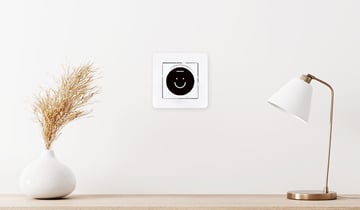
Smart thermostats
Smart thermostats are the ‘all singing and all dancing’ thermostat to help you run your heating as efficiently as possible. Typically, smart thermostats come with more features than standard programmable thermostats. But they have the highest chance of saving homeowners’ money on heating bills if used correctly.
If you have connection to the internet, you’ll be able to control your underfloor heating via an app and access a wide range of features. Unlike programmable thermostats, you’ll find additional features such as geolocation and weather compensation.
Another nifty feature with smart thermostats, like ThermoSphere SmartHome, is that you can connect it via Amazon Alexa and Google Home enabling you to control your heating with your voice.
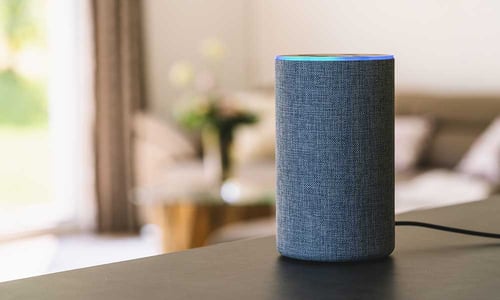
Dual control thermostats
Dual control thermostats are probably the least common type of thermostat in the UK but they add a next level of convenience. If you want to control two heating appliances such as an electric towel bar and your electric underfloor heating, you can. You won’t need to install two thermostats to do it either. A dual control thermostat gives you the ability to set a heating schedule for your floor and for the towel bar (or mirror demister). This is all down to independently switched dual relays inside the thermostat.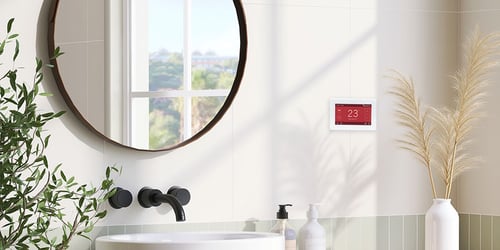
When looking for a thermostat to control your underfloor heating, it’s important to keep the focus on ones that have been purposefully designed to do it and do it well. Even though thermostats like Nest or Hive are generally popular, they aren’t the best heating control for your electric underfloor heating system.
According to Hive’s website ‘Hive Thermostats can be used to support wet underfloor heating systems (which provide heat using pipes) but they do not currently support electric underfloor heating systems.’ When it comes to Nest, some installers use a workaround, which includes installing Nest Heatlink to make it work. But there is a problem with doing this, which we’ll explain.
When running an electric underfloor heating system, different types of floor finishes will have a maximum temperature that should not be exceeded. For example, for floor finishes such as wood, carpet and vinyl the maximum temperature is 27°C. Floor finishes like tile or stone can have slightly higher recommended maximum temperatures. This is because, running the system too hot can potentially damage the floor, especially with soft floor finishes such as vinyl. Typically, thermostats like Nest measure the temperature of the air and not the temperature of the floor so you are unable to effectively set a safe temperature. This causes a greater risk of unwanted damage to the floor finish which will cost you both time and money to fix.

Outside of improving insulation in your home, using your thermostat correctly can have real benefits on how efficient your system runs. When setting up your thermostat, it’s important to not forget to use setback temperatures. By using a setback temperature, your electric underfloor heating system will not fall below the temperature you set when the heating is off. This protects the comfort of your home and really helps with efficiency too.
Does a setback temperature mean my heating will always be on?
No. The heating will be off whilst you’re out, but it will be protected from dropping too low. A setback temperature boosts heating efficiency because it reduces the amount of work your heating must do to maintain a comfortable temperature during the scheduled ‘on’ times.
Let’s look at this example. If your target temperature is 23°C when your heating is on and the setback temperature is 17°C, less energy is needed to get to the target i.e. a 6°C increase. If you don’t use a setback temperature and the temperature drops to 10°C you’ll use more energy to reach the target temperature because you need to increase it by 13°C rather than 6°C.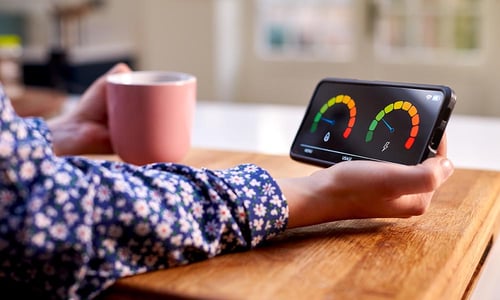
Sometimes if there is a problem with your underfloor heating, it could be down to the thermostat. Here are some things to check if you have a ThermoSphere thermostat installed.
How the thermostat has been wired
All our thermostats have labelled electrical terminals on the back of the unit and wiring diagrams in the instructions but wiring mistakes can happen. To simply check if the thermostat has been installed correctly, carefully pop the thermostat display off the mounting plate and undo the mounting screws. Next, pull the thermostat away from the wall and compare the wiring in your thermostat with the wiring diagram.
Please note that you should only do this if you are competent with electrics, and you have isolated the electrical supply.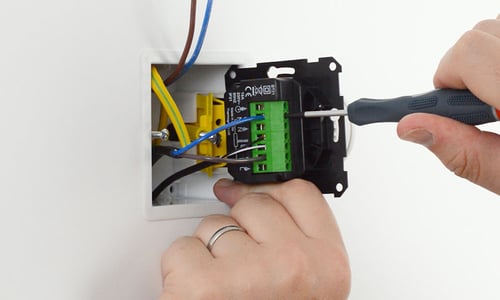
Thermostat settings
The heating will only come on if the temperature you have set is higher than the measured temperature of the floor (if in floor sensing mode). For this section, we’ll be using our most popular programmable thermostat, the SCP-W, as the example.
Start by checking the measured temperature and the desired temperature. On the Programmable Thermostat the measured temperature is the larger number on the left-hand side of the screen and the set temperature is the small number on the right as illustrated below.
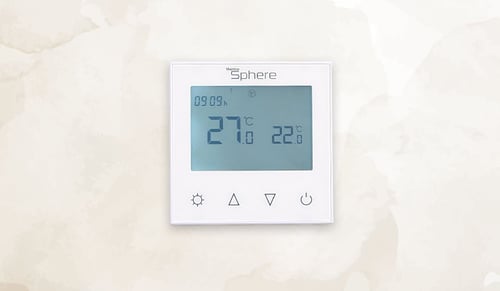
If the set temperature and the measured temperature are both 20°C the heating will not come on. If you press the up arrow to and increase the set temperature above the measured temperature, you will see the flame symbol show up on the display which means the heating is switched on. When the heating reaches the set temperature the flame icon will disappear, and the heating will be off.
Is the heating schedule correct?
We often find that heating schedules need to be adjusted in order for the heating to work when you want it to. To check and edit the heating schedule of the Programmable Thermostat you’ll have to do the following:
If you need further assistance with scheduling your heating, contact the customer service team who are always happy to help.
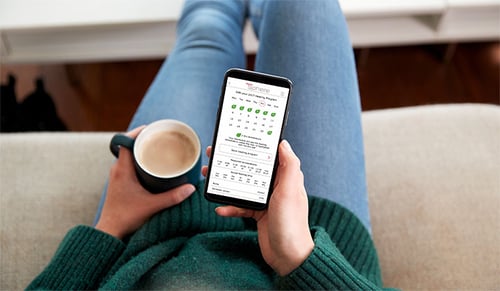
What sensor is the thermostat measuring?
Underfloor heating thermostats are designed to work with a floor temperature sensor, a built-in ambient air temperature sensor or both at the same time. Knowing what sensor your thermostat is using will ensure the system is running as it should.
Let’s look at this example:
The floor could be 6°C warmer than the air in the room and if your thermostat is using the floor sensor and you set it to 23°C, the heating will switch off when the floor reaches 23°C. However, the room may only be at 17°C and therefore still feel cold! Because of this, you may think the underfloor heating is not working properly.
To find out what the right temperature setting you need to feel comfortable, follow this process:
For ultimate efficiency and to help protect the floor finish, we always recommend using both floor and air sensing modes together.
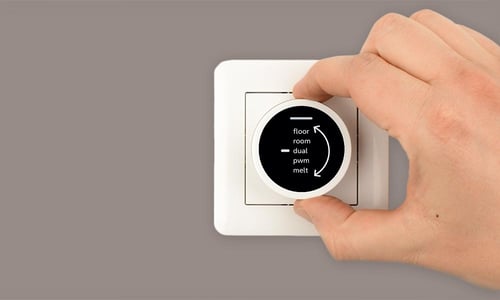
If you have any questions about controlling your underfloor heating system, please contact us via the website or give one of the team a call on 0800 019 5899.
Complete the short form and you'll receive a fast quote turnaround time along with the right product details for your property or project.
Need it even quicker? Call our HQ and one of the team will be happy to help on 0800 019 5899.

5 min read
With the colder months fast approaching, many homeowners will start to think about turning on their heating and some may even be getting new heating...
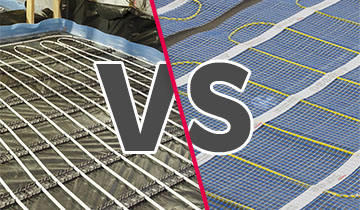
11 min read
In this heating blog article, we will be walking you through both water underfloor heating and electric underfloor heating to help you decide what...

15 min read
There’s nothing quite like stepping onto a warm floor on a chilly morning — which is why it’s so frustrating when your underfloor heating doesn’t do...